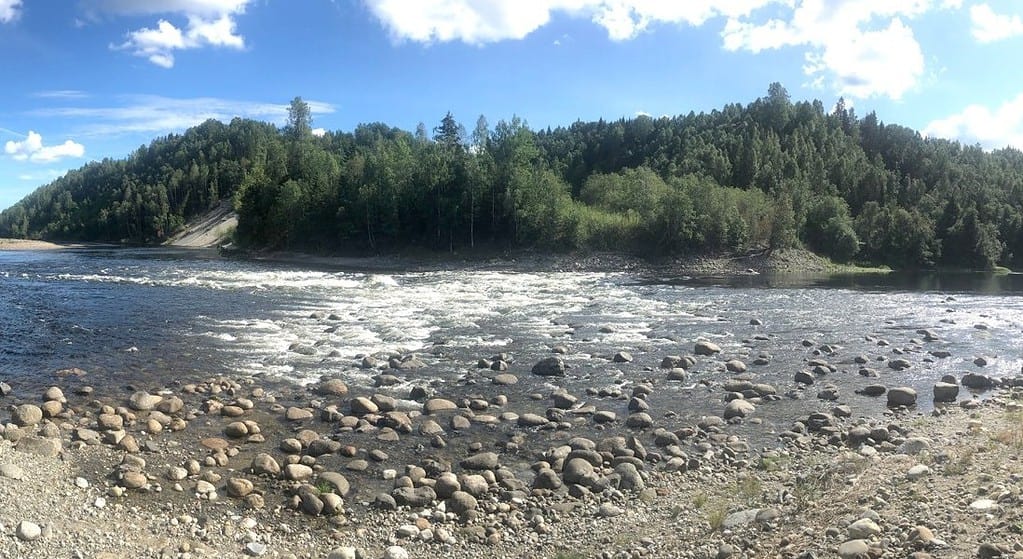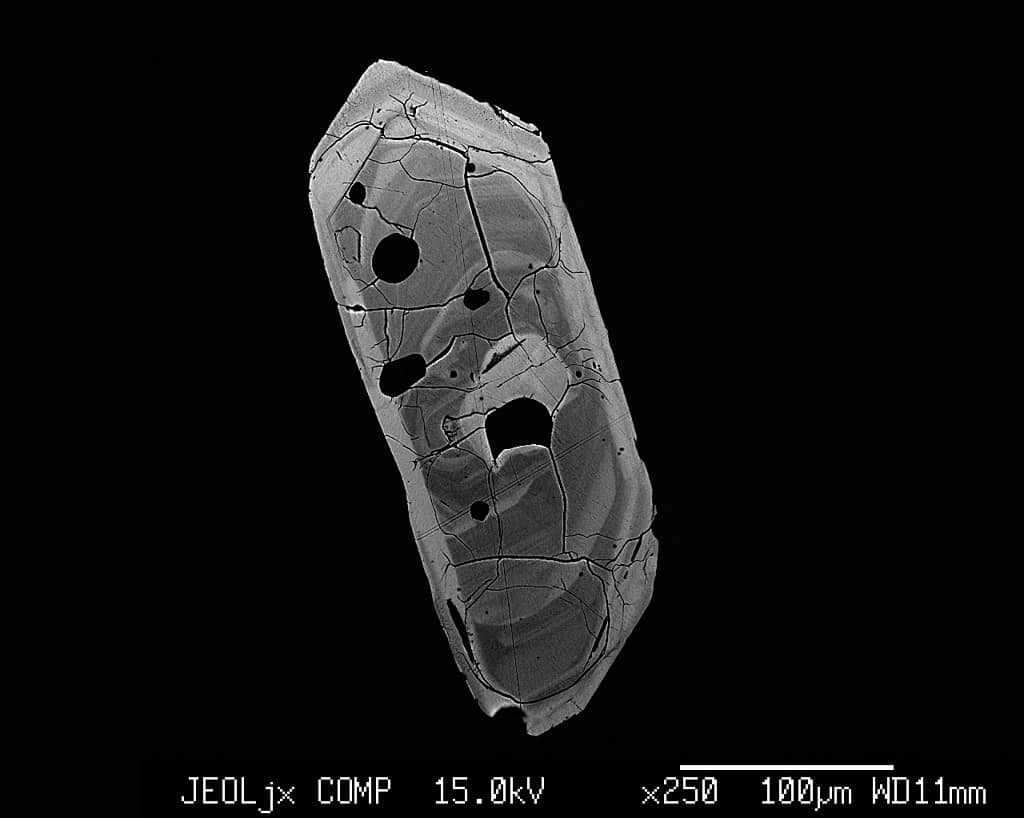
Finland’s mountains are some of the most stable geological structures on Earth. While other places constantly create or destroy new landmass, Finland lies on a “shield” — an area of very old, stable, and exposed bedrock that forms the ancient geological core of a continent.
This means that if you want to look for clues about what happened early in the Earth’s history, it’s a good place to explore. For geologists like Prof. Tod Waight, at the Department of Geosciences and Natural Resource Management, that’s a given.
Undisturbed discovery
Waight and colleagues uncovered an outcrop in a relatively understudied area. The outcrop, nestled between two mountains, contains sand with zircon crystals. These zircon crystals are important because they’re so stable they contain information from billions of years ago.
Zircon crystals in granites form when molten rock material cools and crystallizes, incorporating zirconium, silicon, and oxygen into durable, crystal structures within the granite. These zircon crystals formed in granites deep in the Earth’s crust billions of years ago. The granites were slowly pushed to the surface, gradually reached the surface, and started eroding. Ultimately, only the zircon crystals were left, forming a sort of sand with other rocks.
Because the chemical structure of the zircon is virtually unchanged, the researchers can look for signatures of specific isotopes — variants of a chemical element that have the same number of protons but different numbers of neutrons. In geology, isotopes are important for tracing the origins of rocks because their unique ratios in different materials provide a “fingerprint” that can indicate a rock’s source, formation age, and the environmental conditions at the time of its formation.
With this approach, they were able to show that the chemical fingerprint of the Finnish zircon matches the composition of the older Greenland Craton.
Old and even older
The Greenland Craton, one of Earth’s oldest continental crusts, boasts a complex geological history stretching back over 3.8 billion years. This ancient craton forms a significant part of the North American continent’s northeastern corner, comprising some of the world’s most ancient rocks. The Scandinavian Shield is around 2.5 to 3.1 billion years old — also very old, but not quite as old as the Greenland Craton.
At least this was the theory before this study.
“The zircon crystals we found in river sand and rocks from Finland have signatures that point towards them being much older than anything ever found in Scandinavia, while matching the age of Greenlandic rock samples. At the same time, the results of three independent isotope analyses confirm that Scandinavia’s bedrock was most likely linked to Greenland,” says Department of Geosciences and Natural Resource Management researcher Andreas Petersson.
If this is the case, it means that Scandinavia emerged as a “seed” from Greenland and is actually around 250 million years older than previously thought.
“Our data suggest that the oldest part of Earth’s crust beneath Scandinavia originates in Greenland and is about 250 million years older than we previously thought,” says Professor Waight.


A shifting planet
Our planet’s geology moves around quite a bit. We don’t really notice it because the change is gradual (only a few cm per year), but in geological time, the surface of the planet can change dramatically. Researchers have a fairly good idea of how the continents moved in the past 100, 200, or even 400 million years. They do this by creating dynamic models and analyzing how old different rocks in different parts of the world are.
But when you get to 1 billion years and more, things get very hazy — and there aren’t that many rocks that old left that you can look for.
Geologists suspect that before the continents formed, the Earth was a “water world”, covered almost entirely by oceans.
“Earth was probably a watery planet, like in the movie Waterworld, but without any oxygen in the atmosphere and without emergent crust. But, because that’s so far back in time, we can’t really be sure about what it actually looked like,” says Tod Waight.
Then, the continents started to form, and this was essential to life. Although life emerged in the oceans, the chemistry and interaction between water and continents paved the way for the emergence of life forms that could eventually adapt to live on land, utilizing the diverse environments and resources available there. In fact, our planet seems to have a structure that’s unique in our solar system: it has a granite crust, which is less dense than the basaltic crusts found on other terrestrial planets, contributing to the formation of continents and playing a crucial role in the development of life on Earth.
We’re not exactly sure how important granite is for the emergence of life, but the combination of granite and water seems to be a good one for carbon-based life forms.
“This is unique in our solar system. And, evidence of liquid water and a granite crust are key factors when trying to identify habitable exoplanets and the possibility of life beyond Earth,” explains Andreas Petersson.
When and how did the continents form?
The study also offers an important clue to a puzzle geologists have been trying to solve for some time: how the continents formed in the Earth’s early history.
“Understanding how continents formed helps us understand why ours is the only planet in the solar system with life on it. Because without fixed continents and water in between them, we wouldn’t be here. Indeed, continents influence both ocean currents and climate, which are crucial for life on Earth,” says Andreas Petersson.
The problem is that it’s hard to find rocks that are so old — and even if you do, it’s difficult to confirm the original source. This is where the new method comes in. Specifically, the study authors used isotopic studies of lead, hafnium, and oxygen, and they suggest using the same approach for other “geological” seeds.
“The most commonly used models assume that Earth’s continental crust began to form when the planet was formed, about 4.6 billion years ago. Instead, our and several other recent studies suggest that the chemical signatures showing growth of the continental crust can only be identified about a billion years later. This means that we may need to revise much of what we thought about how early continents evolved,” says Professor Waight.
“Our study provides us with another important clue in the mystery of how continents formed and spread across Earth — especially in the case of the Fennoscandian Shield. But there is still plenty that we don’t know. In Australia, South Africa and India, for example, similar seeds have been found, but we’re unsure of whether they all come from the same “birthplace,” or whether they originated independently of one another in several places on Earth. This is something that we would like to investigate more using the method we used in this study,” concludes Professor Waight.
Journal Reference: Andreas Petersson, Tod Waight, Anthony I.S. Kemp, Martin. J. Whitehouse, John W. Valley. An Eoarchean continental nucleus for the Fennoscandian Shield and a link to the North Atlantic craton. Geology, 2023; 52 (3): 171 DOI: 10.1130/G51658.1
Thanks for your feedback!

